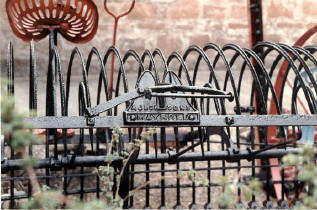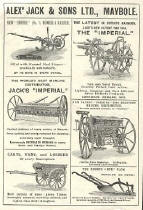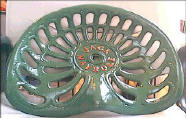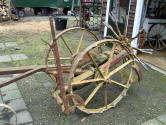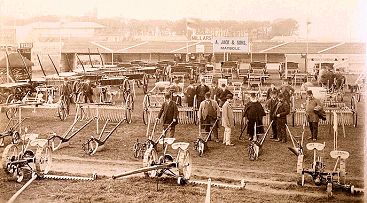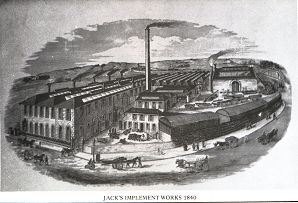|
|||||
|
|||||
|
These photos of Jacks implements in Australia were sent in by Jimmy Eccles. Click on the images to view full size |
|||||
|
Photo dated 25th of April, 1894 contributed by Stuart Butterfield, dealer in vintage photographs. |
Picture above from Maybole - a Pictorial History |
||||
|
A. JACK & SONS, Ltd., Agricultural Engineers, MAYBOLE. |
|||||
|
An old established Firm, well known As makers of most modern plant For "up-to-date" farm work, and trade; Or any other thing you want |
Not merely In the British Isles |
||||
|
Presented below with the generous permission of Elizabeth McFadzean are two articles regarding the business of Alexander Jack and Sons - a significance part of Maybole's industrial and local history. The following article is the copyright © of the author and the Alloway & Southern Ayrshire Family History Society. It is displayed on this site with their kind permission and may not be distributed in any manner without their approval. The article below appeared in issue no. 4, Autumn 1999, of the Journal of the Alloway & Southern Ayrshire Family History Society. Alexander Jack and Son As you enter Maybole on the A77 from Ayr you notice the large stone building on the right next to the Old Parish Church, on Cassillis Road. It is now the head office of The International Packaging Corporation (UK) Ltd, manufacturers of Presentation Cases, but for over 100 years it was the Works of Alexander Jack and Sons, makers of agricultural implements. Mr Jack, having begun business at Auchendrane in 1840, purchased the ground in Maybole in 1852 and built the Works to his own design. An early advert for Maybole Sawmills and Agricultural Implement Works has an engraving of the buildings showing a coach-and-four passing. Another shows a penny-farthing bicycle and various types of carts on The New Yards, old name for Cassillis Road. A display of implements is laid out in the stable yard. An article in The Glasgow Weekly News of 1901 gives a very full description of all the departments of the works... .the Office, the engineering shop, 60 yards long, the blacksmiths’ shop, erecting shop where mowers, reapers, manure distributers, potato diggers, horse rakes, turnip sowers, and other implements were assembled, painting shop, foundry where castings in iron and brass were made, joiners’ shop, sawmill and woodyards.
Bags of sawdust were supplied to local butchers and grocers who scattered it on the shop floors. There was also a wood seasoning tunnel for the cut boards for future carts. The firm was in business in Maybole from around 1852 till 1966. National Archive no 00344 lists records held in 1966 and most of these are in The Scottish Life Archive at the Royal Museum of Scotland, Chamber St., Edinburgh. Among the records is a large collection of photographs of carts and implements taken on the street outside the stable yard. These range from wheelbarrows and farm carts to milk delivery carts. I know from adverts that they also made railway waggons at one time. The Coin and Medal section of the museum holds Jack and Sons collection of gold and silver medals won at Shows all over the U.K. The Scottish Life Archive also has the pattern bevel wheel for the first reaper made in Ayrshire. It used to hang in the Board Room at Jack’s and was given to my father when the firm closed...he had retired in 1964 before that, having earned his gold watch for sixty year’s service 1900-1961. The names on the wheel are Charles McFadzean, Millwright, Crosshill and Hugh McFadzean and David Dick, pattern makers. It is dated 1853. Hugh was my grandfather and Charles was his brother. By 1861 Hugh was in Maybole and became works manager for Mr Jack. He died in 1912. His sons Hugh B. and Charles T. became managing director and works manager respectively. My brother H. Hastings McFadzean also worked in Jacks for a short time before emigrating. The Firm had an excellent reputation in Scotland and beyond. The Freight Books list exports e.g. on The Marion in 1861 from Liverpool to Melbourne, hammershalts for stonebreakers, pick shafts and guano bruisers. In 1899 they shipped implements to South Africa. There is much more of the history of the firm for me to find. The Rev. Roderick Lawson often mentions it in his writings on Maybole and has articles on Mr Jack and his son-in-law John Marshall who carried on the business after Mr Jack’s death in 1877. Mr Jack’s tombstone is in Maybole Old Cemetery. I have been trying to find the Apprentice Registers of the firm without success. They were listed in archive number 00344 at the Scottish Record Office ( Now the National Archive ) in 1966 when the firm ceased trading. The other items listed are in the Scottish Life section of the National Museums of Scotland in Edinburgh. No one can find the registers which were for 1886---1914 and 1914 ---1931. If you can suggest a means of locating them please contact me by clicking on my email address below. The following article is the copyright © of the author and the AYRSHIRE ARCHAEOLOGICAL AND NATURAL HISTORY SOCIETY. It is displayed on this site with their kind permission and may not be distributed in any manner without their approval. The article below appeared in No. 16 Spring, 1999 issue of Ayrshire Notes ALEXANDER JACK AND SONS, MAYBOLE In 1901, the Glasgow Weekly Herald, as part of an ongoing series entitled 'Captains of Industry' turned its attention on the Maybole agricultural implement works of Alexander Jack & Sons. The article, in the Weekly Herald of 27th July 1901, begins with some philosophical ruminations on the culture of the soil and the history of farm implements and machinery. It then goes on to say: "There are several firms in Scotland devoted to the making of agricultural implements and machinery. Messrs Alexander Jack & Sons of Maybole may be taken as representative of that branch of the industry. "The founder of the firm of Alexander Jack & Sons was a cartwright, who carried on his trade at Auchendrane, on the banks of the Doon near Maybole. He began business about 1835 and gradually developed a trade in the making of implements for farms round about. Mr Jack appears to have been a man of special energy and original genius, for he soon gained a reputation more than local. In 1852 he purchased ground in Cassillis Road on the outskirts of Maybole and built works planned by himself for his growing industry. Those works, both in external appearance and internal arrangement tell something of Mr Jack's spirit and genius. Situated beside Maybole Parish Church, the works bear a strong outward resemblance to an old-fashioned kirk. Square and plain, the doorways and windows are ornamented, the windows lead-framed and rimmed with coloured glass, the building presents an appearance singularly unlike the ordinary engineering work. The motto 'laborare est orare' might fitly be inscribed on its portal and whether consciously or unconsciously that idea seems to have inspired the architect and builder. Mr Jack put his whole mind into his work and he had his reward. "In 1876, Mr John Marshall, the present head of the firm, was taken into partnership, and at the death of Mr Jack took over the whole control of the business. Mr Marshall, though not a trained engineer, has done much to maintain and enhance the firm's reputation. In fact, it must be said, that during his rule the firm has attained its highest prosperity. Locally respected: he has been Provost of Maybole, and the esteem in which he is generally held by his fellow engineers is shown by his election to President of the Scottish Agricultural Engineers. "To the city visitor who expects a free-and-easy condition of things in the country factory the office arrangements must be surprising. There is the enquiry counter, and behind it the counting house, just as though it were in the heart of Glasgow. Businesslike and spacious, the offices are on the second floor of the front building. The land slopes upwards to the back, and on a level with the counting house the large engineering shop extends back for about sixty yards on an earthen floor. Here all kinds of iron-turning machines are at work. Lathes varying from three feet bed up to sixteen feet; drills vertical and horizontal, planers, slotters, screw and tapping machines are cutting and shaping the metal parts of agricultural implements. "Further back, at the very end of the shop, the blacksmiths have their fires and anvils, for the wheel rims have yet to be forged by the blacksmith's art and brawny force; the plough-irons are sharpened and tempered anew in the fire and on the ringing anvil. Thus the old craft and the new machines work hand-in-hand. To the right is the erecting and painting shop. Here mowers and reapers, manure distributors, potato diggers, horse rakes, turnip sowers and various other agricultural implements are put together. A few yards beyond, apart from the rest of the works, is the foundry. The castings done in the foundry are not large, but the patterns are varied and the castings numerous. From the high cupola at the end of the buildings the molten metal is run in ladles to rows of dark matrix boxes, and poured into one after the other. Brass fittings are also cast in the foundry, and brass finishing machines change the rough castings into bright and burnished pieces of metal. "The engineering department is only one division of these works. Messrs Jack & Sons are cartwrights and sawmillers as well. In the yards flanking both sides of the works huge stacks and stores of timber are gathered. Thirty-five thousand felloes and a corresponding number of spokes are kept constantly in stock, while many tons of timber half-prepared and in rough logs lie awaiting the saws. At the side of the woodyard the log saws are constantly at work, and in the adjoining machine-shops the newest wood-turning lathes are fashioning spokes and naves and felloes with marvellous rapidity. The machinery here differs little from that of a cabinet factory. Circular saws, band saws, lathes, tenoning, mitreing, planing and cutting machines shape the hard and heavy pieces of timber for cart and carriage body or wheels. One of the most interesting appliances in the place is a new machine devised for putting on wheel tyres. The old method was to put the tyre on hot, and thus the felloe was charred and partially injured. By this new machine the tyres are put on cold. Shaped like a circular cistern, the heavy blocks ranged round its inner edge, the machine received the wooden frame of the wheel. A cold iron tyre or rim is laid round it, and the wheel is firmly fixed at the centre. The workman slowly turns a crank and what appeared to be solid blocks of iron move simultaneously forward. Look below and see slender tubes running into the metal blocks. Within these tubes hydraulic power is at work, irresistibly drawing forward the blocks which now have pressed all round the iron tyre, squeezing it firmer and firmer onto the wooden wheels. The pressure is relaxed, and a completed wheel is lifted up. To make sure the tyre is lightly trimmed and subjected again to pressure. Users of wheeled vehicles will not require to be told what a great boon that machine confers on them. "In the cart and carriage building department numerous vehicles are being made up. Common carts, hay carts, lorries, vans, dog-carts and other vehicles are in various stages of completion. One specialty of the firm should have to be noted. It is called a HAY-RICK LIFTER, and transfers bodily the hay-rick from the field at a single effort. Constructed like a bevelled lorry, the bottom of the lifter rests on the ground, the ropes are put round the rick, a handle at each side pulls the ropes tighter and tighter, dragging the rick on to the floor of the lifter, which is backed slowly under it. Contrasted with the old hay fork, this lifter is a great advance. In these works genuine labour is done, and an interesting industry is carried on. So much may be said safely. "Messrs Alexander Jack and Sons have many medals and trophies and on all sides appear to have attained high position in their special line of business. Agriculturalists have instituted shows for horses and cattle, and awarded medals and prizes for excellence; they have carried the principle into the implement yard. The practice is an admirable one; for the rough test of the market is not always fair". |
